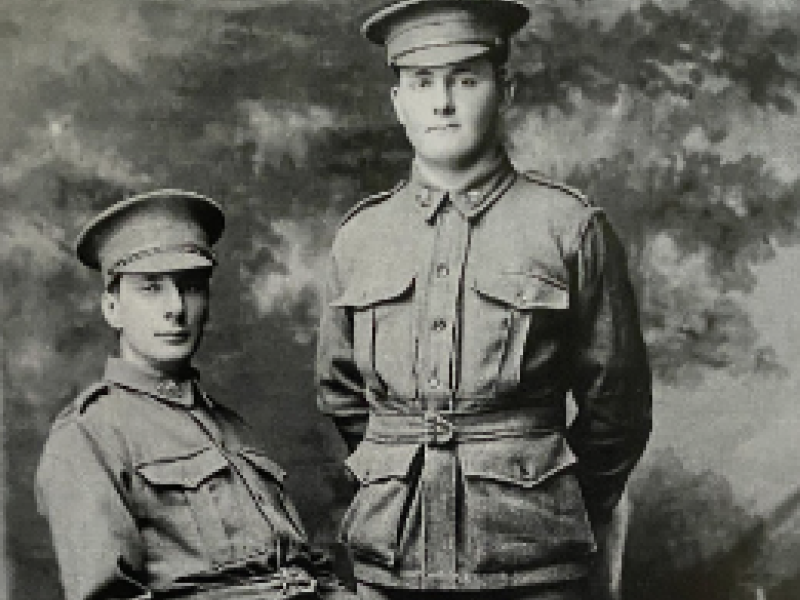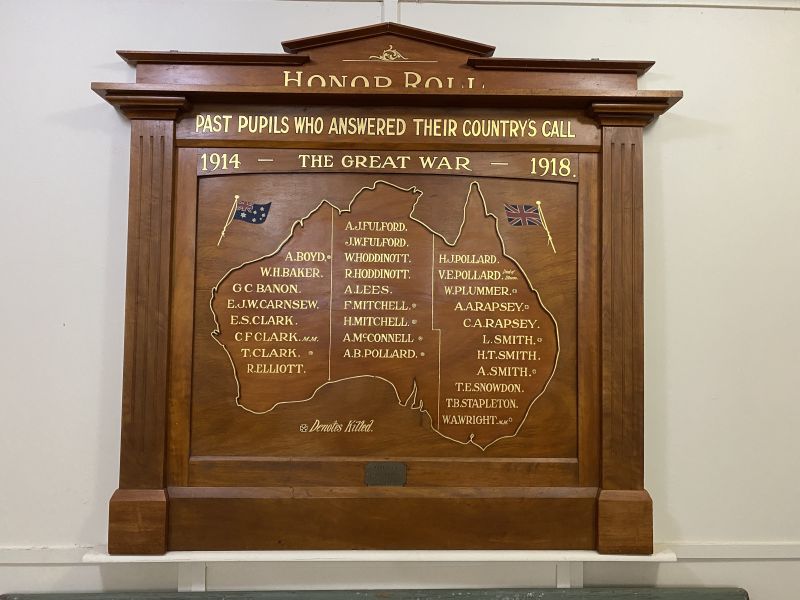Matthew Hawton Mitchell
Matthew (on the right), and his twin brother Fred, were born on the 3rd of August 1897 at Wodonga, Victoria. They were the eldest children of Braddon and Hannah Elizabeth (née Parnaby) and would eventually have four other siblings, three brothers and one sister. The family was a farming family and lived in the Bethanga area. The Mitchell children all attended the Bonegilla State School (No. 1749).
Matthew enlisted in the 1st AIF with his twin brother, Fred, on the day of their 18th birthday, the 3rd of August 1915. Being under the age of 21, Matthew and Fred needed their parents' consent to enlist. Matthew was allocated the Regimental Number 3542 and, like his brother, was posted to the 8th Reinforcements for the 24th Battalion. He spent time in training camps at Bendigo, Seymour and Williamstown before embarking in HMAT A19 Afric at Melbourne on the 5th of January 1916.
Arriving in Egypt he was transferred to the 8th Battalion on the 24th of February. Following a further month of training the battalion embarked on HMT Megantic on the 26th of March and sailed for France. They disembarked at the Port of Marseilles on the last day of March.
August 1916 through to January 1917 saw Matthew admitted to various hospitals for two lengthy periods. The first ailment he suffered from was an infection of the middle ear. This was serious enough for him to be sent back to England for care. The second ailment was a common one for soldiers during this time period and that was mumps. In this case he was admitted to the 18th General Hospital at Camiers on the coast of northern France. Matthew arrived back to his unit on the 15th of January 1917.
On the 20th of September, Matthew was promoted to Lance Corporal. He was given UK (United Kingdom) leave on the 9th of January 1918. Part of his leave was spent with relatives in Cornwall. It was during his leave that he was told of Fred’s death. This may have been the reason he decided to stay longer than the official leave period and did not return to his unit until the 10th of February. For this offence he lost his chevron (Lance Corporals have one chevron, a V shaped pattern, on their sleeves) and forfeited 18 days pay.
Early June of 1918 saw Matthew back in hospital, this time suffering from a bout of influenza. He spent ten days in the 58th Casualty Clearing Station, arriving back at his unit on the 14th of June. Five days later he was again promoted to Lance Corporal. On the 22nd of August he was promoted to full Corporal.
On the 23rd of August, the 8th Battalion, as part of the 1st Australian Division, took part in a major advance towards the village of Chuignes. This attack involved two Australian Brigades (8 battalions), two dozen Mark V tanks and several carrier tanks. The objective of the operation was to move across the Chuignes valley and take the eastern heights. It was a huge success although it claimed approximately 1000 Australian casualties. At some stage during the advance Matthew was wounded by shrapnel in his thigh along with a femur being fractured. His wounds were severe and complicated by secondary haemorrhaging. The surgeons made the decision to amputate his leg. Although he recovered slightly, he collapsed and died at 1830 hours on the 1st of September 1918.
Matthew was buried in the Abbeville Communal Cemetery Extension, Plot IV Row D No. 18, France. He is also remembered on the Australian War Memorial Roll of Honour and the Bonegilla Roll of Honour. For his service he was awarded the British War Medal and the Victory Medal.
Three weeks after the armistice, Braddon Mitchell passed away and was buried in Sunbury cemetery. At some stage during the next few years, Annie took her four remaining children and moved back to the Wodonga area. She purchased the homestead of a property in Beechworth Road, which was then being run by her son James. Annie named the homestead “Bailabbe” a word formed from the names of the two towns in France where her twins were buried.

 Stephen Learmonth
Stephen Learmonth